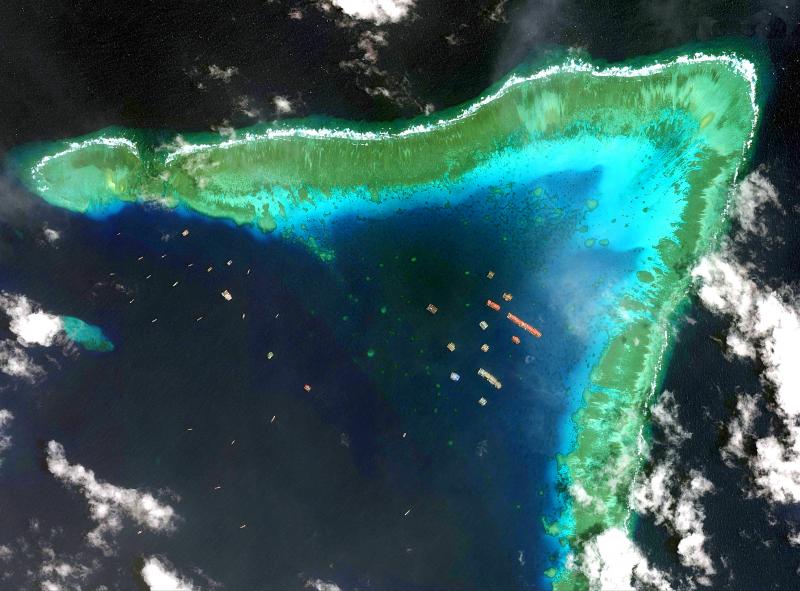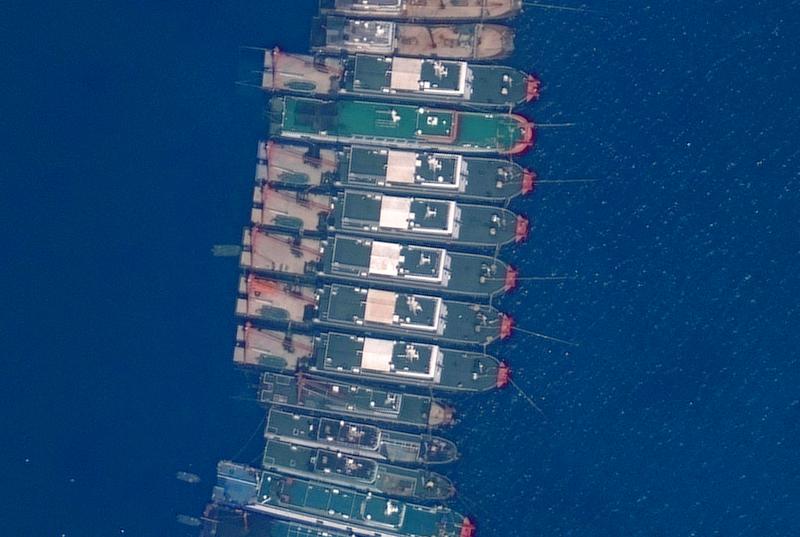For the last two decades, there has been a growing chorus of think pieces arguing that the US should clarify its position on Taiwan and end its policy of “strategic ambiguity,” its refusal to announce an official position stating clearly whether and under what conditions it would defend Taiwan.
Like antibodies rushing to defend a breach in the skin, such articles then attract wave after wave of essays contending that ending strategic ambiguity is a bad idea.
PRECEDENTS

Photo: Maxar Technologies via AFP
Yet, just off Taiwan are two cases that can shed light on the problems at the heart of strategic ambiguity, the Philippines and Japan. Farther off, the subcontinent offers several others, including India, Nepal and Bhutan.
If observers wish to see what might happen when the US commitment is “clear,” they need merely consider the cases of the Philippines and Japan, both of which have mutual defense treaties with the US that compel it to come to their aid if attacked.
At present, China occupies features in the South China Sea that indisputably belong to the Philippines, such as Scarborough Shoal (Huangyan Island, 黃岩島, also claimed by Taiwan). It uses both fishing boats and paramilitary vessels to carry out these activities. While the US has made noise, Chinese boats remain at Scarborough and elsewhere in the South China Sea.

Photo: Reuters
This occupation, though overt theft, has not triggered a US military response.
Similarly, the Diaoyutai Islands (釣魚台, known as the Senkaku Islands in Japan, also claimed by Taiwan and China), Japanese since the late 19th century, have been the site of numerous incursions by Chinese boats in recent years. The US has publicly stated that it includes the Senkakus in its mutual defense treaty with Tokyo, and years ago, even carried out wargames there with Japanese defense forces.
This clarity — repeated on a regular basis by US officials — has not deterred China from pushing its ships and aircraft into the area, and then withdrawing them.
Indeed, looking at the Philippines and Japanese cases, it is not difficult to conclude that US clarity actually makes it easier for China to carry out its provocative acts of aggression, because the treaty lets China know what it can and cannot do. It also enables China to locate and then define the boundaries of US action via constant testing of them.
Beijing is carrying out some of the same activities at the moment against Taiwan, testing Taiwan with planes, but more importantly, with sand dredgers off Matsu’s coast. This has forced Taiwan to conduct round-the-clock patrols of the area, even as Matsu’s communications cables and tourism are disrupted by the Chinese dredgers. China deploys hundreds of dredgers, against less than a dozen Coast Guard vessels from Taiwan.
Yet, it has not physically occupied any features that are indisputably Taiwanese, such as islands in Penghu. Nor have the dredgers appeared elsewhere off Taiwan-controlled waters. When Taiwan Coast Guard ships appear, the dredgers generally withdraw, to return when they are gone.
Beijing does not know how the US will react to more aggressive moves against the possessions of Taiwan. Perhaps that is encouraging restraint.
Perhaps it is merely a matter of time.
Those who argue that the US should end its policy of strategic ambiguity should take a hard look at Philippines and Japan, and the US (non-)response to Chinese incursions.
FICKLE US POLICY?
They should also consider the fickleness of US policy, shifting from year to year and administration to administration. Imagine, for example, if the hopelessly weak and compromised administration of president Barack Obama had ended strategic ambiguity. What definition of US policy would we now be constrained by?
Recently many observers have been cheered by strong US statements about its relationship with Taiwan. Indeed, some officials have even said that Taiwan is no longer viewed as a problem by the US.
For example, a State Department official said: “Taiwan is not looked at as a problem anymore, but as a success story.” Sorry, my bad. That was from 2002.
Meanwhile, China is also pursuing policies of expansion in the Himalayas, a major flashpoint. The seizure of land features belonging to India brought a sharp response from New Delhi. China is certain that India will react vigorously, yet it continues its expansionist policies.
It also has seized land belonging to Nepal and to Bhutan. Surveys done last year by the government of Nepal indicated that land in seven different districts had been seized by China. Similarly, this year it was revealed that China had been constructing roads, buildings and military facilities in a valley belonging to Bhutan since 2015.
Nepal, Bhutan, and Philippines are militarily weak, and can do little against Chinese aggression. India and Japan are much stronger.
None of this array of postures and strengths seems to mean much in the face of Chinese aggression. China presses on them all, weak or strong, allied or alone, carefully but persistently.
Commentators often forget that another purpose of strategic ambiguity is to deter Taipei, though this aspect of the policy has been less explored in recent years. Strategic ambiguity thus deters both sides, at least in the US view.
PRETEXT OF CIVIL UNREST
It is not difficult to imagine how, if the US had a clear policy of intervention in the case of Chinese attack, the situation could be exploited by a Chinese Nationalist Party (KMT) president. If a KMT president could incite “civil unrest” in Taiwan through some absurdly pro-China move, like China-friendly former president Ma Ying-jeou (馬英九) did with the two trade and services agreements, what is to stop him from calling for People’s Liberation Army troops to “restore order?”
What if a KMT president were to invite Chinese troops in to help with typhoon relief? How would Washington react, if its red lines had already been drawn elsewhere?
At the moment, strategic ambiguity is important not only because China does not know what the US would do in the case of an invasion, but also because Beijing does not know where the boundaries of the US response are located. Literally anything from a full-scale invasion to a White House fit of pique could trigger an armed response from Washington.
Yet, what the incursions into others’ territories in the Himalayas, in the South China and in the Senkakus suggest is that, in the long term, “strategic ambiguity” is simply going to become irrelevant.
Beijing will do what Beijing will do: “salami slicing” against its opponents irrespective of their policies or positions, their strengths or weaknesses. The current debate over “strategic ambiguity” in US circles signals, not the coming of a shift in the US position, but its rapidly growing irrelevance.
Notes from Central Taiwan is a column written by long-term resident Michael Turton, who provides incisive commentary informed by three decades of living in and writing about his adoptive country. The views expressed here are his own.

Most heroes are remembered for the battles they fought. Taiwan’s Black Bat Squadron is remembered for flying into Chinese airspace 838 times between 1953 and 1967, and for the 148 men whose sacrifice bought the intelligence that kept Taiwan secure. Two-thirds of the squadron died carrying out missions most people wouldn’t learn about for another 40 years. The squadron lost 15 aircraft and 148 crew members over those 14 years, making it the deadliest unit in Taiwan’s military history by casualty rate. They flew at night, often at low altitudes, straight into some of the most heavily defended airspace in Asia.

Many people in Taiwan first learned about universal basic income (UBI) — the idea that the government should provide regular, no-strings-attached payments to each citizen — in 2019. While seeking the Democratic nomination for the 2020 US presidential election, Andrew Yang, a politician of Taiwanese descent, said that, if elected, he’d institute a UBI of US$1,000 per month to “get the economic boot off of people’s throats, allowing them to lift their heads up, breathe, and get excited for the future.” His campaign petered out, but the concept of UBI hasn’t gone away. Throughout the industrialized world, there are fears that

Like much in the world today, theater has experienced major disruptions over the six years since COVID-19. The pandemic, the war in Ukraine and social media have created a new normal of geopolitical and information uncertainty, and the performing arts are not immune to these effects. “Ten years ago people wanted to come to the theater to engage with important issues, but now the Internet allows them to engage with those issues powerfully and immediately,” said Faith Tan, programming director of the Esplanade in Singapore, speaking last week in Japan. “One reaction to unpredictability has been a renewed emphasis on

Taiwan’s democracy is at risk. Be very alarmed. This is not a drill. The current constitutional crisis progressed slowly, then suddenly. Political tensions, partisan hostility and emotions are all running high right when cool heads and calm negotiation are most needed. Oxford defines brinkmanship as: “The art or practice of pursuing a dangerous policy to the limits of safety before stopping, especially in politics.” It says the term comes from a quote from a 1956 Cold War interview with then-American Secretary of State John Foster Dulles, when he said: ‘The ability to get to the verge without getting into the war is